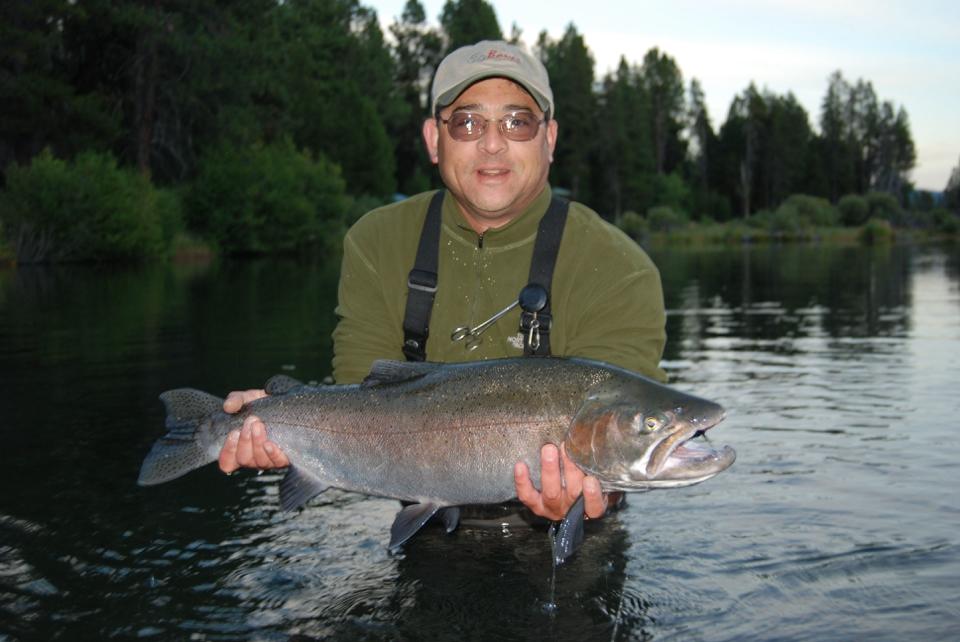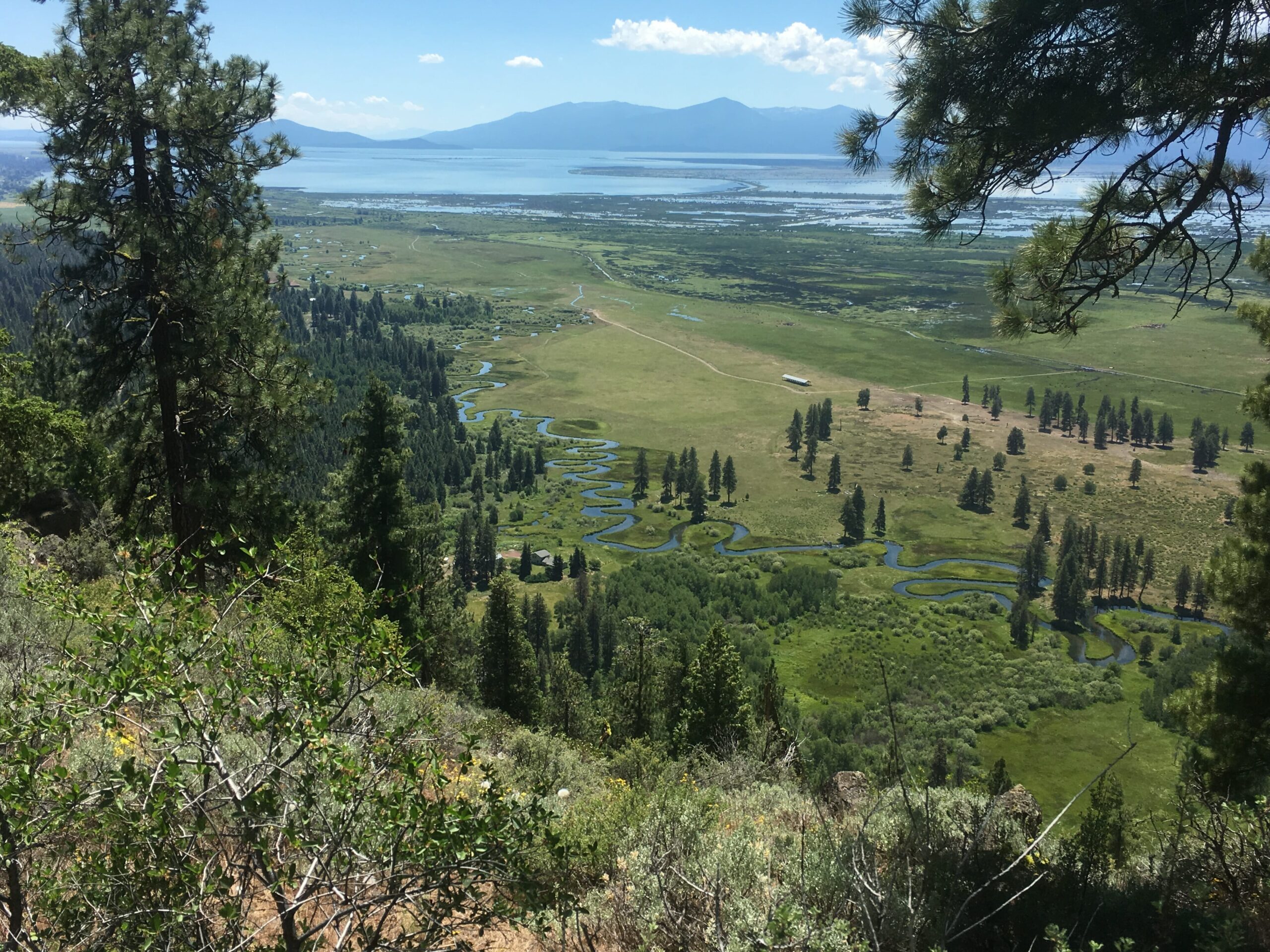Upper Klamath Lake and one of the many fine spring creeks in this area.
By Sam Davidson
My first fishing experience on a true spring creek was in the upper Klamath River basin in southern Oregon.
I knew little ab
out such waters in those days. I took a detour while on a long road trip and spent an hour or two tossing spinners to unseen but reportedly enormous trout—as strong and hot as steelhead, I was assured by a friend of a friend—in the slow swirls of a stream called the Williamson River.
On that initial visit I had no real idea of how to tempt the giant redbands that come out of Klamath Lake into this and other feeder streams during the summer, seeking cooler conditions. I just found a place where I could get to the bank, hoped it wasn’t private property, and fished as I did for any kind of trout in those days—slinging and rapidly retrieving a Rooster Tail or Panther Martin.
I got a good helping of skunk for my efforts.
The second time I fished the Williamson was more recently, with my friend Derek, who years ago bought property on this river and has made it into the kind of retreat many anglers dream of. Simple, rustic, functional, with game mounts on the walls and an expansive workshop, the whole place unobtrusive among the pines.
And a thirty-second walk from his back door to the river.
Derek was a middle school science teacher and a bit of a throwback—he’s a lifelong, avid sportsman who did it all. He took his profession equally seriously, brooked no nonsense from his students, taught fly tying classes and was beloved by kids and their parents alike.
I know, because he taught the wonders of physics and chemistry to my two kids when they were that age.

The photo from the wall of Derek’s classroom.
Derek’s classroom decorations were sparse. But on my first visit to his work space I spied a 3×5 photo tacked to the wall in the vicinity of a poster of the periodic table. It was of Derek, half submerged in a stream, cradling a massive trout that was easily ten pounds.
“That’s a heck of a steelhead,” I observed.
“That’s not a steelhead,” Derek replied.
It took several visits with Derek, and lengthy conversations about fly fishing and local turkey and deer hunting, before he began to let on what type of fish that actually was and where, sort of, he had caught it.
The Williamson isn’t exactly a secret. But locals are reluctant to crow much about its treasures.
They needn’t worry, really. There is very little wading water on the Williamson and the fishing is highly technical. Until you know this water, to have much hope of success you really need to float it with a guide or a local savant like Derek.
I felt like royalty when Derek invited me to spend some time with him at his place on the river. A year or two later I actually did.
It was too early in the season for most of the lake fish. But we strung up 6-wts and dropped into pontoon boats and rowed up river to a spot where we could anchor and stand on a rib of rock.
Derek had given me a few of the flies he tied specifically for these fish in this stream. They were smaller and simpler than I expected. I looked at the one I had tied to the end of a long leader and felt a little performance anxiety.
Derek offered me the first few casts but I demurred. The water was much clearer and the seams more complicated than I was used to. I thought I would watch him, and try to emulate his tactics.
Easier said than done. Derek’s casting was effortless and accurate and his line management impeccable. After a few drifts, there was an almost imperceptible tension in his line. He strip-set and there was a huge boil of water in the bucket a little way downstream of us.
Then the line went slack.
I had trouble believing how much water had been displaced by that boil. I was shaking. Derek said, “Well, at least there’s one in there,” and stepped back to let me cast. Which I did poorly, spooking whatever fish were within a hundred yards of that lie.
That was the extent of the action over the several hours we fished together. Derek was encouraging, telling me where to stop and cast, how to finesse the retrieve. But we got no more grabs.

TU’s Josh Duplechian, hard at work on one of the upper Klamath’s many spring creeks.
I thought about that day recently, when I returned to that area for the first time since fishing with Derek. I was there with Trout Unlimited’s camera maestro, Josh Duplechian, for a film project on TU’s remarkable work in the upper Klamath basin.
In the tributaries to Klamath Lake, large and small, TU is partnering with ranchers to restore habitat and fish passage and boost dry season streamflows. This work benefits bull trout, the eponymous redbands and other native fishes, and is prepping the upper basin for the return of salmon and steelhead to Klamath Lake when four downstream dams are removed from the Klamath River, likely in 2021.
At the end of the third, long day I cajoled Josh into taking a break from his relentless camera work to take a few casts on the Williamson.
I spent maybe an hour wade fishing one of the few places where that is possible on this river. I caught one lovely, 8-inch native redband trout for my pains. Josh was more productive, eschewing a rod for some artistic camera play.
Standing in a beautiful stretch of flowing water with glorious trout in it is usually a tonic. But this time melancholy attended me. I knew what it was. I wore it close, like the buff around my neck.
Two years ago, at an age when no one worries about this sort of thing, Derek suffered a serious stroke. Some doctors told him he would never walk again. But Derek is way too ornery to accept such a diagnosis. In a short time he proved them wrong.
Today, he’s out of a wheelchair and is able to move about, carefully, under his own power. The right side of his body, including his casting arm, remain impaired, although his rehabilitation has been remarkable.
He has adopted a persona he calls Shadow Man. Shadow Man can’t cast a fly rod. Yet.
Sometimes Derek struggles to remain optimistic about further improvements in his mobility, and battles with regret. Were his eating habits really that bad, his stress level really that high? But he is enlivened by visits from his young grandsons, and days spent in a blind hunting local bucks and toms with a couple of his former students.
Derek is up at his place on the Williamson right now. These days, it is both salve and torment for him. I missed him by a week. I imagine him there, watching the light change over the course of the day on his beloved water, listening to its whispers, healing.
Sam Davidson is TU’s communications director for California and Oregon.



